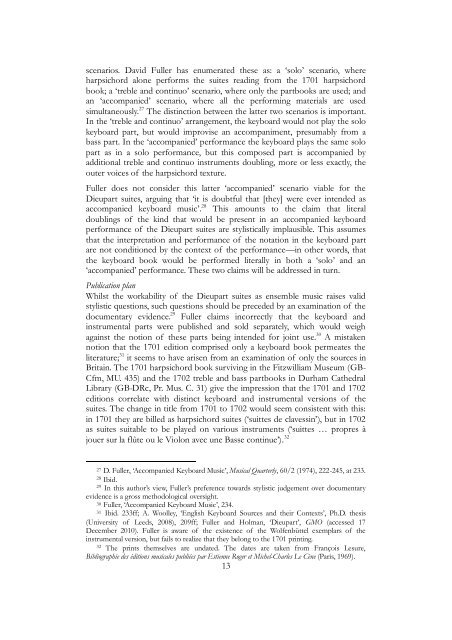Partiturbuch Ludwig - The Viola da Gamba Society
Partiturbuch Ludwig - The Viola da Gamba Society
Partiturbuch Ludwig - The Viola da Gamba Society
Create successful ePaper yourself
Turn your PDF publications into a flip-book with our unique Google optimized e-Paper software.
scenarios. David Fuller has enumerated these as: a ‘solo’ scenario, where<br />
harpsichord alone performs the suites reading from the 1701 harpsichord<br />
book; a ‘treble and continuo’ scenario, where only the partbooks are used; and<br />
an ‘accompanied’ scenario, where all the performing materials are used<br />
simultaneously. 27 <strong>The</strong> distinction between the latter two scenarios is important.<br />
In the ‘treble and continuo’ arrangement, the keyboard would not play the solo<br />
keyboard part, but would improvise an accompaniment, presumably from a<br />
bass part. In the ‘accompanied’ performance the keyboard plays the same solo<br />
part as in a solo performance, but this composed part is accompanied by<br />
additional treble and continuo instruments doubling, more or less exactly, the<br />
outer voices of the harpsichord texture.<br />
Fuller does not consider this latter ‘accompanied’ scenario viable for the<br />
Dieupart suites, arguing that ‘it is doubtful that [they] were ever intended as<br />
accompanied keyboard music’. 28 This amounts to the claim that literal<br />
doublings of the kind that would be present in an accompanied keyboard<br />
performance of the Dieupart suites are stylistically implausible. This assumes<br />
that the interpretation and performance of the notation in the keyboard part<br />
are not conditioned by the context of the performance—in other words, that<br />
the keyboard book would be performed literally in both a ‘solo’ and an<br />
‘accompanied’ performance. <strong>The</strong>se two claims will be addressed in turn.<br />
Publication plan<br />
Whilst the workability of the Dieupart suites as ensemble music raises valid<br />
stylistic questions, such questions should be preceded by an examination of the<br />
documentary evidence. 29 Fuller claims incorrectly that the keyboard and<br />
instrumental parts were published and sold separately, which would weigh<br />
against the notion of these parts being intended for joint use. 30 A mistaken<br />
notion that the 1701 edition comprised only a keyboard book permeates the<br />
literature; 31 it seems to have arisen from an examination of only the sources in<br />
Britain. <strong>The</strong> 1701 harpsichord book surviving in the Fitzwilliam Museum (GB-<br />
Cfm, MU. 435) and the 1702 treble and bass partbooks in Durham Cathedral<br />
Library (GB-DRc, Pr. Mus. C. 31) give the impression that the 1701 and 1702<br />
editions correlate with distinct keyboard and instrumental versions of the<br />
suites. <strong>The</strong> change in title from 1701 to 1702 would seem consistent with this:<br />
in 1701 they are billed as harpsichord suites (‘suittes de clavessin’), but in 1702<br />
as suites suitable to be played on various instruments (‘suittes … propres à<br />
jouer sur la flûte ou le Violon avec une Basse continue’). 32<br />
27 D. Fuller, ‘Accompanied Keyboard Music’, Musical Quarterly, 60/2 (1974), 222-245, at 233.<br />
28 Ibid.<br />
29 In this author’s view, Fuller’s preference towards stylistic judgement over documentary<br />
evidence is a gross methodological oversight.<br />
30 Fuller, ‘Accompanied Keyboard Music’, 234.<br />
31 Ibid. 233ff; A. Woolley, ‘English Keyboard Sources and their Contexts’, Ph.D. thesis<br />
(University of Leeds, 2008), 209ff; Fuller and Holman, ‘Dieupart’, GMO (accessed 17<br />
December 2010). Fuller is aware of the existence of the Wolfenbüttel exemplars of the<br />
instrumental version, but fails to realize that they belong to the 1701 printing.<br />
32 <strong>The</strong> prints themselves are un<strong>da</strong>ted. <strong>The</strong> <strong>da</strong>tes are taken from François Lesure,<br />
Bibliographie des éditions musicales publiées par Estienne Roger et Michel-Charles Le Cène (Paris, 1969).<br />
13

















